Day 1 :
Keynote Forum
Henk-Maarten Laane
MD, ReXil Agro BV, Netherlands
Keynote: SAAT: Silicic acid agro technology/the use of silicic acid in agriculture
Time : 10:55 - 11:25

Biography:
Henk-Maarten Laane is a MD starting his professional career in 1967 at the University of Amsterdam in the field of Anatomy, Physiology and Pathology. Worked as GP and Coroner for the City of Amsterdam (1973-2000). Since 1990 involved in medicine research for HIV/AIDS. Degree in Social Medicine. Since 2000 research on the health effects of Silicon on humans and animals, resulting in the registration and introduction of (patented) silicic acid as food supplement. Based on these supplements also experiments were started on plants. The results showed very positive growth stimulating effects due to the as well the soil as foliar application: the Silicic Acid Agro Technology (= SAAT) was ‘born’. Based on ongoing experiments since 2001 we have shown that (stabilized) silicic acid is very effective as biostimulant, next to its effect on biotic and abiotic stress factors resulting in (much) higher yields with higher quality.
Abstract:
For optimal growth all relevant nutrients are needed. Among the nutrients, silicon is an ignored nutrient due to the common opinion that plants do not suffer from Si deficiency. In most soils there is an abundant presence of Ai as silicates, silicon dioxide or biogenic silica. But silicates, SiO2 are hardly/not plant available. Only (mono-) silicic acid is plant available, but its concentration in the soil is very low causing a silicic acid deficiency. This is due to several reasons like the instability of this molecule which polymerizes very fast. Based on patented production processes stabilized, plant available and plant active silicic acid is now used in agriculture: the silicic acid agro technology. SAAT can be used as foliar spray and as soil and hydroponic amendment. In many trials since 2003 this stabilized SA has shown to be very effective on almost any plant. Increases in yield, biomass and quality has been shown in many crops, as well monocots as dicots, like rice, sugarcane, sweet corn, tobacco, okra, watermelon, tomato, chili peppers, grapes, etc. Results on several crops will be presented. SA is speeding up plant growth by a larger root system, longer and thicker tillers/stem, larger leaf surface with higher chlorophyll content, etc. SA decreases as well abiotic as biotic stresses resulting in healthier plants allows reducing the use of pesticides significantly. The shelf life is increased and the post-harvest losses are decreased. SAAT is safe (for the plant, the soil and the consumer), ecofriendly and cost-effective. Silicic acid is a bio-stimulant, a fertilizer as well as a plant protectant.
Keynote Forum
Prakash Nagabovanalli B
President of the International Society for Silicon in Agriculture and Related Disciplines
Keynote: Prospects of Different Sources of Silicon in Agricultural and Horticultural Crops
Time : 11:25 - 11:55

Biography:
Dr. N. B. Prakash, Professor of Soil Science at University of Agricultural Sciences, Bangalore, India, has dedicated research on Silicon in Agriculture. He has contributed immensely in identifying silicon deficient areas and categorization in different soils of South India. Dr. Prakash organized the Indo US workshop on Silicon in Agriculture during 25-27 February 2010 and the 8thPSILPH at UAS, Bangalore during 18-22 October 2012. He has guided 14 master and 4 PhD students in soil science. He has contributed for release of silicon based technology (Recycling of rice hull ash and foliar silicic acid) in the package of practices of UAS, Bangalore. He has more than 40 publications published in national and international journals to his credit. Being President of the International Society for Silicon in Agriculture and Related Disciplines since 2014, he will be involved in organising 7th International Conference on Silicon in Agriculture in 2017 at UAS, Bangalore, India
Abstract:
Silicon (Si) is found beneficial in many crops and promotes the growth and development of plants under abiotic and biotic stresses. In the past decade, studies have focused on a better understanding of the mechanism involved in the Si transport and confirmed Si uptake by plants at the molecular level. Weathering reactions, leaching and intensive cultivation of high yielding cultivars can reduce the concentration of plant available Si in soil. This emphasizes the need for a good Si source in agricultural and horticultural crops.
The addition of silicate materials to crops started in Japan in the early 1950s and is commonly used in many parts of the world such as Korea, Taiwan, Thailand and Sri Lanka, Brazil, South Africa, USA and other countries. Wollastonite (CaSiO3), iron and steel mill slags or their derivatives, K and Na silicates, foliar/ liquid formulations, Si minerals, calcium silicate hydrate, silica gel, thermo-phosphate, Diatomite, rice straw, rice hull, rice hull ash, sugarcane bagasse and other Si rich crop residues are the commonly used Si sources in different crops. But, for field application an ideal Si source should possess attributes like local availability, cost effectiveness, easy to handle, Si solubility and improve plant available Si and Si bioavailability, environment friendly and improve crop growth and yield. In India, the preliminary experiments using Si fertilization have given promising results in field crops like rice, maize, finger millet, sugarcane and potato and horticultural crops like grapes, tomato, pomegranate and banana. Calcium silicate and rice hull ash applied @ 2 to 4 t Si ha-1 and foliar silicic acid @ 2- 4 ml L-1 were found to improve Si content and crop yield. Application of slag improved the Si and Zn nutrition of rice with a favourable benefit: cost (B:C) ratio over calcite application
Keynote Forum
Beatrice Berger
Leibniz Institute of Vegetable and Ornamental Crops, Germany
Keynote: Harnessing Plant Growth-Promoting Bacteria for Sustainable Agriculture
Time : 11:15 - 11:35

Biography:
Beatrice Berger has her expertise in plant nutrition and plant ecology. She aims to improve the quality and yield of food plants by beneficial bacteria and fungi. Together with Silke Ruppel, that has started to establish the rhizobacteria Kosakonia radicincitans as a model organism, she is investigating the interaction of plant-beneficial bacteria to harness K.radicincitans for agricultural systems. Her research focus is on ecophysiological and molecular aspects of the interaction under abiotic and biotic stresses. The team is complemented by Matthias Becker who is working on the evolution and processing of K. radicincitans.
Abstract:
Statement of the Problem: Conserving arable soils is one of the major challenges in agronomy for our and future generations. Using beneficial native microorganisms such as plant growth-promoting bacteria contributes to sustainability in agricultural systems and helps maintain stable yields and product quality. However, the growth-promoting effects of candidate strains observed in pot trials often disappear under field conditions.
Methodology & Theoretical Orientation: Kosakonia radicincitans was isolated from winter wheat; after establishing cultivation of the strain under laboratory conditions, biological atmospheric nitrogen fixing and phytohormone producing ability was demonstrated. Systemic application of K. radicincitans on glasshouse-grown plants revealed significant growth-promoting effects on various vegetables and crop plants. We evaluated the plant growth potential of K. radicincitans in radish (Raphanus sativus var. sativus L.), maize (Zea mays) and winter wheat (Triticum aestivum) when plants were grown under glasshouse and field conditions.
Findings: Leaf- and tuber weights of inoculated radish plants were significantly increased by up to 25%, biomass of maize up to 30% and grain yield gain in winter wheat was demonstrated to be up to 20% after bacterial application under field conditions.
Conclusion & Significance: We demonstrate the capability of K. radicincitans to persist in plants and promote plant growth under field conditions. Therefore, K. radicincitans is a promising candidate for further processing as a growth-promoting product in sustainable agriculture.
Keynote Forum
Paolo Benincasa
University of Perugia, Italy
Keynote: Refining and bran grinding levels of wheat flours besides baking properties affect tensile characteristics of derived bio-plastics
Time : 11:15 - 11:35

Biography:
Paolo Benincasa is Associate Professor at the Dept. of Agricultural, Food and Environmental Sciences of the University of Perugia. He has 25-year expertise in Crop Science and Technology. His research activity focused on the evaluation of agronomic aspects affecting crop yield and quality and on the management of crop residues and soil fertility in conventional and organic farming systems. Recently, together with his colleagues of the Materials Engineering group, he has started working on biobased materials looking at the factors (cultivar, environment, cultivation practices, post-harvest manipulation) that may affect the mechanical properties of derived manufactures. Novel findings are reported in articles published or under consideration in high ranked journals.
Abstract:
Statement of the Problem: There is a recent literature on the use of wheat flours to obtain bio-plastics as an energetically and economically cheap alternative to purified starch. Previous researches from our group demonstrated that the tensile properties of thermoplastic films depended on wheat grain hardness and baking properties of refined flours, expressed as Chopin’s Alveograph parameters (P, L, P/L and W). No research, however, has considered the use of wholegrain flours, while this could be of relevance because the bran could work as reinforcement instead of being a by-product to get rid of when exceeding the need for livestock feeding.
Aim: The purpose of this study is to describe the mechanical performance of thermoplastics obtained from wheat flours differing for grain hardness, alveographic parameters and refining and bran grinding level.
Methodology: Grains of four common wheat (Triticum aestivum L.) cultivars (Altamira, Aubusson, Blasco, Bologna) were milled separately in a laboratory mill in order to produce single-cultivar refined (R) or wholegrain flour with fine (F) or gross (G) bran grinding. Grain hardness and alveographic parameters for R flours were reported by Benincasa et al. The flours were then plasticized, filmed and tested for tensile properties (strengths; elongation at breake) according to Puglia et al.
Results: The bran reduced e but increased s for the films derived from any of the four cultivars. The s was higher and e was lower in films from F than G flours. The reasons for the effect of refining and bran grinding levels were discussed based on SEM microscopy of films which revealed that bran and its texture affected starch granules exposure to plasticizer.
Conclusion & Significance: Both the alveographic parameters and the refining and bran grinding levels of wheat flours represent novel choice factors to consider tailoring manufactures according to requirements and
- Oral Session
Location: Netherlands
Session Introduction
Liang Chen
Tea Research Institute- Chinese Academy of Agricultural Sciences, China
Title: A high density genetic map for underlying the QTLs associated with the main quality and functional components, such as catechins, caffeine in tea plant (Camellia sinensis)

Biography:
Liang Chen has completed his PhD on Tea Science at Zhejiang University, China and Post-doctoral studies at Cornell University, USA. Now, he is the Associate Director of National Center for Tea Improvement, TRICAAS. He has published more than 40 papers in reputed journals and has been serving as an Editorial Board Member of repute.
Abstract:
Flavonoids and methylxanthine are key flavor and functional components of tea. To identify the genetic factors underlying the regulation of catechins and caffeine accumulation in the tender shoots of tea plant, quantitative trait loci (QTL) studies were carried out in a pseudo-testcross population derived from an intraspecific cross between two varieties of Camellia sinensis. A high density with more than 6600 SSR/SNP markers interval mapping and restricted multiple QTL model mapping detected a total of 25 QTLs and 13 QTLs associated with catechins and methylxanthine content, respectively. Of the 25 QTL associated with catechins content, nine stable QTLs were validated across years and clustered into four main chromosome regions on LG03, LG11, LG12 and LG15. The population variability explained by each QTL was predominantly at moderate-to-high levels and ranged from 2.4% to 71.0% with an average of 17.7%. The total number of QTL for each trait varied from four to eight, while the total population variability explained by all QTLs for a trait ranged between 38.4% and 79.7%. 13 QTLs associated with methylxanthine content including caffeine content (CAF), theobromine content (TBR), total content of caffeine and theobromine (TC) and caffeine-to-theobromine ratio (CTR) over four measurement years. The QTLs detected clustered onto five linkage groups. Among them, one stable QTL (qCAF1) controlling CAF was mapped on LG1 and validated across all years, explaining an average of 18.9% of the phenotypic variance. The other QTL were identified in only one or two years and of them, there were six, two and four QTL for TBR, TC and CTR, respectively. This study presents the first example of QTL detection for methylxanthine related traits in tea plant. The results presented here provide a foundation for further fine mapping and cloning functional genes and elucidating mechanism of flavonoids and methylxanthine accumulation in tea plant.
Beatrice Berger
Leibniz Institute of Vegetable and Ornamental Crops, Germany
Title: Harnessing Plant Growth-Promoting Bacteria for Sustainable Agriculture

Biography:
Beatrice Berger has her expertise in plant nutrition and plant ecology. She aims to improve the quality and yield of food plants by beneficial bacteria and fungi. Together with Silke Ruppel, that has started to establish the rhizobacteria Kosakonia radicincitans as a model organism, she is investigating the interaction of plant-beneficial bacteria to harness K.radicincitans for agricultural systems. Her research focus is on ecophysiological and molecular aspects of the interaction under abiotic and biotic stresses. The team is complemented by Matthias Becker who is working on the evolution and processing of K. radicincitans.
Abstract:
Statement of the Problem: Conserving arable soils is one of the major challenges in agronomy for our and future generations. Using beneficial native microorganisms such as plant growth-promoting bacteria contributes to sustainability in agricultural systems and helps maintain stable yields and product quality. However, the growth-promoting effects of candidate strains observed in pot trials often disappear under field conditions.
Methodology & Theoretical Orientation: Kosakonia radicincitans was isolated from winter wheat; after establishing cultivation of the strain under laboratory conditions, biological atmospheric nitrogen fixing and phytohormone producing ability was demonstrated. Systemic application of K. radicincitans on glasshouse-grown plants revealed significant growth-promoting effects on various vegetables and crop plants. We evaluated the plant growth potential of K. radicincitans in radish (Raphanus sativus var. sativus L.), maize (Zea mays) and winter wheat (Triticum aestivum) when plants were grown under glasshouse and field conditions.
Findings: Leaf- and tuber weights of inoculated radish plants were significantly increased by up to 25%, biomass of maize up to 30% and grain yield gain in winter wheat was demonstrated to be up to 20% after bacterial application under field conditions.
Conclusion & Significance: We demonstrate the capability of K. radicincitans to persist in plants and promote plant growth under field conditions. Therefore, K. radicincitans is a promising candidate for further processing as a growth-promoting product in sustainable agriculture.
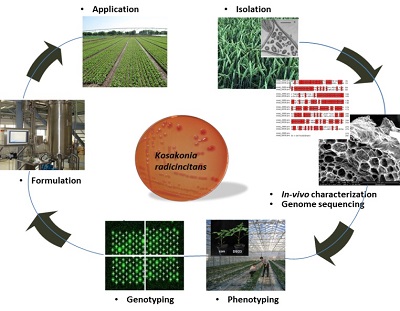
Figure 1: Process of isolation, characterization and application of Plant Growth-Promoting Bacteria Kosakonia radicincitans.
Paolo Benincasa
University of Perugia, Italy
Title: Refining and bran grinding levels of wheat flours besides baking properties affect tensile characteristics of derived bio-plastics

Biography:
Paolo Benincasa is Associate Professor at the Dept. of Agricultural, Food and Environmental Sciences of the University of Perugia. He has 25-year expertise in Crop Science and Technology. His research activity focused on the evaluation of agronomic aspects affecting crop yield and quality and on the management of crop residues and soil fertility in conventional and organic farming systems. Recently, together with his colleagues of the Materials Engineering group, he has started working on biobased materials looking at the factors (cultivar, environment, cultivation practices, post-harvest manipulation) that may affect the mechanical properties of derived manufactures. Novel findings are reported in articles published or under consideration in high ranked journals.
Abstract:
Statement of the Problem: There is recent literature on the use of wheat flours to obtain bioplastics as an energetically and economically cheap alternative to purified starch (1). Previous researches from our group (2-3) demonstrated that the tensile properties of thermoplastic films depended on wheat grain hardness and baking properties of refined flours, expressed as Chopin’s alveograph parameters (P, L, P/L, W) (4). No research, however, has considered the use of wholegrain flours, while this could be of relevance because the bran could work as reinforcement (5) instead of being a by-product to get rid of when exceeding the need for livestock feeding. The purpose of this study is to describe the mechanical performance of thermoplastics obtained from wheat flours differing for grain hardness, alveographic parameters, and refining and bran grinding level. Methodology: Grains of four common wheat (Triticum aestivum L.) cultivars (Altamira, Aubusson, Blasco, Bologna) were milled separately with a laboratory mill in order to produce single-cultivar refined (R) or wholegrain flour with fine (F) or gross (G) bran grinding. Grain hardness and alveographic parameters for R flours are reported in Benincasa et al (2). The flours were then plasticized, filmed and tested for tensile properties (strength, s; elongation at break, e) according to Puglia et al (3). Findings: The bran reduced e but increased s for the films derived from any of the four cultivars. The s was higher and e was lower in films from F than G flours. The reasons for the effect of refining and bran grinding levels are discussed based also on SEM microscopy of films, which revealed that bran and its texture affected starch granules exposure to plasticizer. Conclusion & Significance: Both the alveographic parameters and the refining and bran grinding levels of wheat flours represent novel choice factors to consider for tailoring manufactures according to requirements and uses.
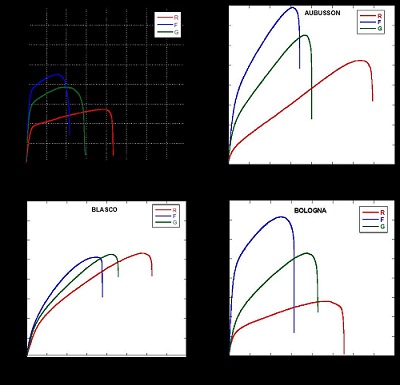
Fig: Stress-strain curves for thermoplastic films from four wheat single cultivar (Altamira, Aubusson, Blasco and Bologna), flours, refined (R) or wholegrain with fine (F) or gross (G) bran grinding level.
Poonam Singh
Assiniboine Community College, Canada
Title: Managing western flower thrips by the use of bio-control agents in conventional and solar greenhouses

Biography:
Poonam Singh is a Researcher and Instructor at Assiniboine Community College’s Horticultural Production and Sustainable Food Systems programs. She holds a Bachelor of Science Degree in Agriculture; a Bachelor of Education Degree; a Master of Science Degree in Landscaping and Floriculture and; a Doctorate Degree in Horticulture. A majority of her experience relates to teaching, research and outreach within horticultural sciences. Her major research interest includes “Development of technologies/products for sustainable horticultural production, enhancing food security in Canadian First Nation communities, exploration and enrichment of plant germplasm for genetic enhancement and plant physiological studies”.
Abstract:
Western flower thrips (Frankliniella occidentalis) are one of the most important greenhouse pests in Canada and throughout the world. They have a wide host range that includes greenhouse vegetable crops, flower crops, ornamentals and nursery crops. Thrips scratch and pierce their mouthparts into plant tissue to suck out the cellular contents. This results in the deformation of flowers, leaves, shoots and fruits. The damage by thrips reduces the photosynthetic area, weakens plant vigour, destroys the plants visual appeal and produce unmarketable thrips also transmit and spread plant viruses. A study was initiated at Assiniboine Community College’s sustainable greenhouse with three conditions; a conventional greenhouse and two solar greenhouses. The objective was to control pests by using biological control agents (living beneficial organisms called natural enemies) and minimize the use of chemical pesticides in the greenhouse. There are a variety of vegetable, nursery and ornamental crops being grown this greenhouse. Before setting up this experiment, a concerted effort was made to control thrips through various pesticide applications with little success. Thrips control was extremely difficult for several reasons. Adult female thrips lay eggs inside the leaf or petal tissue such that the eggs are protected from pesticides. The eggs hatch into larvae which usually remain protected in flower buds or foliage terminals. During the next stage, the insects move down into the growing media to pupate and remain protected from pesticides. Since the two stages (egg and pupal) are completely protected from direct contact with pesticides, successful control with chemicals was limited. The experiments began with regular monitoring the pest population in all three conditions. Amblyseius cucumeris (predatory mite) was applied on plant alone and was applied along with soil applications of Steinernema feltiae (parasitoid nematodes) to reduce number of larvae feeding on plants and the adults emerging from pupation. Our results revealed that these biological controls agents tested were highly effective at controlling thrips. The pest population numbers and crop damage were significantly reduced in the greenhouse. Effectiveness of bio-control agents to control thrips was higher when both A. cucumeris and S. feltiae were used together as compared to when A. cucumeris was used alone. Within a six months’ time period, weekly monitoring revealed that the thrips population in the conventional greenhouse decreased from 132 to 15 per 4 inch2 yellow sticky card. In the first solar greenhouse, thrips decreased from 50 to 5 per 4 inch 2 yellow sticky cards. The second solar greenhouses saw a reduction from 30 thrips to 3 per 4 inch 2 yellow sticky cards. Currently no pesticide has been applied for over a year. The thrips are being successfully managed using only bio-control agents. Bio-control agents have proved to be safe, effective, environment friendly, target specific (in comparison to chemical pesticides) and are providing a long-term solution to the pest problems.
- Sustainable Agriculture | Agro-ecology & Bioenergy| Forestry & Global Climate Change| Bio Based Materials |Rice Research | Types of Agriculture| Natural Resources Management
Session Introduction
Abdirashid Elmi
Kuwait University, Kuwait
Title: Organic agriculture as a form of sustainable farming and public perception

Biography:
Abdirashid Elmi is a soil Scientist with expertise in Nutrient Cycling (C, N and P), Greenhouse Gas Emissions and Agricultural Water Quality issues. As an Agricultural/Environmental Scientist, his research investigates “Production systems that are environmentally and economically sustainable, including those that mitigate greenhouse gas emissions by increasing carbon sequestration”. He has published over 30 peer-reviewed scientific publications and two textbook chapters. He is an Associate Chief Editor for a number of international journals in Soil/Environmental Science.
Abstract:
Kuwait is one of the few countries in the world that depend entirely on food imports for food security. Consequently, there is a sense of urgency to promote local food production to meet, partly at least, the growing food demand. Local farmers are adopting organic agriculture on a growing scale with little experience and absence of well-defined standards against which the quality of their products can be measured. This study is designed to investigate the organic farming in Kuwait by comparing the organically grown vegetables with conventional grown vegetables samples. Total phosphorus (TP) and total nitrogen (TN) contents were higher in the organically grown than in conventional crops. A striking observation was high concentrations of heavy metals (As, Pb, Cu and Zn) under organic crops than conventional crops, a sharp contrast with the findings of previous studies. With respect to survey study, results indicate that people perceive organic food as a healthy and safe food to consume.
Feibo Wu
Zhejiang University, China
Title: Tolerance to combined stress of drought and salinity in Tibetan wild barley

Biography:
Feibo Wu completed her PhD in 2003 at Zhejiang University (ZJU). She is the Deputy Director of Crop Science Institute-Zhejiang University. Her main research interest includes “Evaluation and identification of plant germplasm, mainly in barley, tolerant to abiotic stresses and its molecular physiology, and phytoremediation of metal-contaminated environments and safe crop production”. She has published 97 papers in reputed SCI-journals and has been serving as an Editorial Board Member of Plant Growth Regulation.
Abstract:
Drought and salinity are the major abiotic stresses that limit agricultural production and dramatically threaten the food supply worldwide. Development of barley for improved drought and salinity resistance requires the knowledge of physiological mechanisms and genetic control of the contributing traits. Tibetan annual wild barley is rich in genetic variation. Here, we demonstrate the physiological and molecular differences between Tibetan wild (XZ5, drought-tolerant; XZ16, salinity/aluminum-tolerant) and cv. CM72 (salinity tolerant cultivar) in response to individual and combined stresses (D+S) of drought (4% soil moisture, D) and salinity (S). Tibetan wild barley XZ5/XZ16 showed to be more tolerant to combined stress of drought and salinity than cv. CM72. The stress tolerance mechanism of wild barley is partially attributed to lower Na+/K+ ratio, improved water use efficiency (WUE), increased capacity of anti-oxidative enzymes to scavenge reactive oxygen species (ROS), increased activities of the carbohydrate and secondary metabolism related enzymes relative to cv. CM72. Comparative proteomic analysis identified 34 differentially expressed proteins (DEPs) related tolerance to drought and salinity alone or a combination. Differentially regulated proteins predominantly had functions in photosynthesis, but also in detoxification, energy metabolism, and protein biosynthesis. Importantly, identification of stress responsive proteins and higher expression of their related genes i.e. SAM3, BSA1, PDX11 and TUFA in Tibetan wild barley represents the stress adaption mechanisms. Our findings add knowledge that wild barley is a treasure trove of useful genes and offer rich sources of genetic variation which can be exploited
in future efforts for breeding barley for multiple stress tolerance.
Metin Turan
Yeditepe University, Turkey
Title: Effects of humic acid on nitrogen contents of wheat plant

Biography:
Metin Turan has completed his PhD in Soil Science at Ataturk University. He is currently working as a Full Professor in Genetics and Bioengineering department at Yeditepe University. He has published more than 100 papers in reputed journals and has been serving as an Editorial Board Member of repute.
Abstract:
This study was conducted on greenhouse conditions. The trial was conducted in 60 pots with an experimental design of 1x4x5 factorial, one plant (wheat), and four humic acid doses (0, 2, 4 and 8 lit da-1). Each treatment was five replicate. Plant and soil samples were taken at the end of the growing period. Plant and soil nitrogen contents and plant grain were determined. The results obtained have shown that plant nitrogen contents significantly affected the wheat plant growing and soil conditions. The highest wheat nitrogen contents were obtained at 4.00 lit da-1 humic acid application doses. But the highest available soil nitrogen contents were obtained at 8.00 lit da-1 humic acid application doses. The lowest plant nitrogen contents were obtained in control group. Positive correlations were determined between the humic acid and wheat plant nitrogen contents and dry matter. Especially, optimum wheat nitrogen contents were obtained at 2.80 lit da-1 humic acid application dose to the other applications.
Shambhavi Yadav
Forest Research Institute, India
Title: Marker-trait association analysis for grain calcium content in global collection of finger millet genotypes

Biography:
Shambhavi Yadav has her expertise in Molecular Plant Breeding. Her research work has been focused on “Use of molecular genetics and transcriptomics approaches in understanding calcium accumulation in finger millet”. She has done genetic diversity and population structure analyses in diverse finger millet germplasm and carried out linkage and association mapping to reveal quantitative trait loci for calcium content trait. Her work also include in silico mining of simple sequence repeats in finger millet developing-seed transcriptome thereby generating rich SSR resource in finger millet. Currently, she is working in the area of “Genetics and propagation of important forest trees and medicinal plants and also involved in in vitro conservation of forest genetic resources”.
Abstract:
Statement of the Problem: Increased calcium content in cereals could result in biofortification for combating mineral deficiencies. Finger millet (Eleusine coracana) is one such crop with grains highly rich in calcium. Understanding the genetic basis of grain calcium content (GCC) is critical for improvement of finger millet. In present study, marker-trait association for GCC in finger millet was explored using association mapping.
Methodology & Theoretical Orientation: A global collection of 238 genotypes was taken for present study and genotyped using 85 genic and non-genic simple sequences repeats (SSR) markers. Phenotyping for GCC was done using atomic absorption spectrophotometry. Association analysis of SSR allelic data with GCC was carried out using TASSEL 3.0.1 software.
Results: The 85 SSRs yielded 160 scorable alleles, of which 62 were polymorphic with polymorphic information content ranging from 0.143 to 0.781 at an average of 0.359. GCC across 238 genotypes ranged from 0.07% to 0.45%. Association analysis revealed two genomic SSRs UGEP78 and UGEP60 to be significantly associated to GCC quantitative trait loci (QTL) at threshold (P) value≤0.001 and exhibiting phenotypic variance (R2) of 6.4 to 13.8% respectively. Genotypes GPHCPB45 and GPHCPB44 from North-West Himalayan region of India and exotic genotypes IE2957 and IE6537 were found to possess highest GCC. These may be effectively used as parents in genetic improvement programs.
Conclusion & Significance: In present study, marker UGEP60 found linked to QTL for GCC belongs to linkage-group 1B of finger millet which shows co-linearity with rice chromosome 1 harboring a calcium content QTL and thus fine mapping around QTL on finger millet linkage-group 1B could lead to identification of potential genes affecting this trait. Moreover, identified markers could be used in map based cloning and marker assisted introgression. The present study therefore, provides a basis for genetic improvement of calcium content in finger millet.
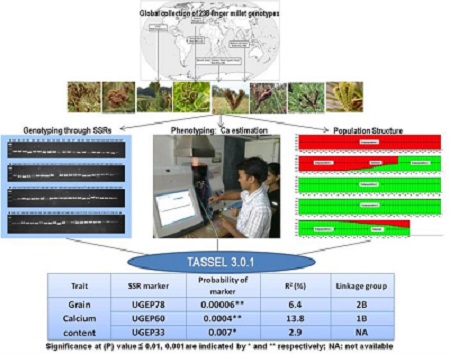
Figure1: Determination of marker-trait association for grain calcium content in finger millet
Asma Osivand
Tokyo University of Agriculture and Technology, Japan
Title: Comparison of allelopathic activity of some edible mushroom and wild mushroom in Japan

Biography:
Asma Osivand completed her MSc thesis entitled “Investigating the possibility of producing hybrids with single-spore isolates of Pleurotus florida”. She is pursuing her PhD in Bio-regulation science at Tokyo University of Agriculture and Technology and her thesis entitled “Allelopathy of edible and wild mushroom” with the aim of finding new biochemical to use it as safe herbicide.
Abstract:
Wild mushrooms have been always considered as valuable source of bioactive compounds, while edible mushrooms have been known for their importance as food source. However, their interaction with plants through chemicals that could lead to find new biochemical has not been well undertaken. A special bioassay method (sandwich method) was applied to compare eight common edible mushrooms (Pleurotus eryngii, Pleurotus citrinopileatus, Pleurotus ostreatus, Lentinula edodes, Grifola frondosa, Flammulina velutipes, Hypsizygus tessellatus and Pholiota namako) with some wild species (Ganoderma appelanatum, Amanita pantherina, Artomyces pyxidatus, Morchella conica, Tricholosporum porphyrophyllum, Trametes hirsuta) for their phytotoxicity against lettuce. Among all tested edible mushrooms, application of 5 mg of P. ostreatus showed stronger allelopathic activity by inhibiting the growth of radicle and hypocotyl of lettuce by 84% and 63% respectively. Moreover, same amount of T. porphyrophyllum exerted 77% and 67% growth inhibition on radicle and hypocotyl of lettuce. In general biochemical contributed in tested mushrooms could be the main cause for their inhibitory activity and could lead to find new allele-chemicals.
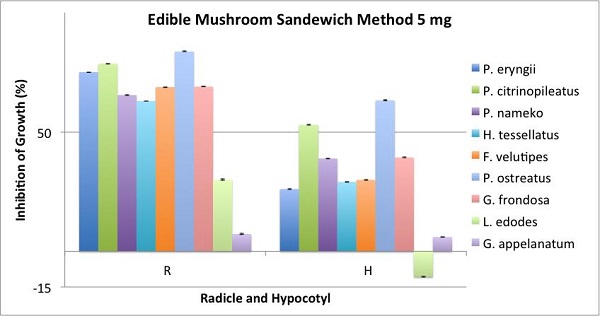
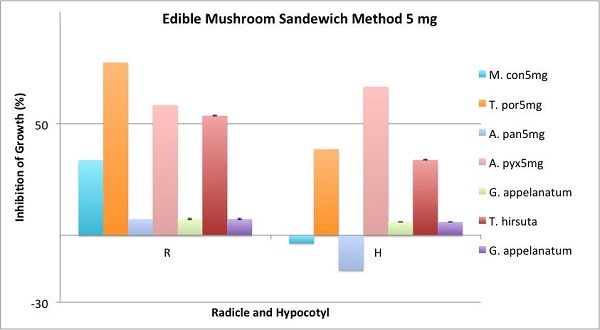
Figure1: A) 5mg sandwich method of edible mushrooms have shown. B) The sandwich method of 5mg wild mushrooms have illustrated.
- Special Session
Session Introduction
D N Kambrekar
University of Agricultural Sciences, India
Title: Chlorantraniliprole 0.4 GR: Featuring a novel mode of action against grape stem borer, Celosterna scabrator

Biography:
D N Kambrekar is an Assistant Professor of Agricultural Entomology in Department of Agricultural Entomology at University of Agricultural Sciences, Dharwad, India. He has worked on “Bio-pesticides mainly on viral pesticides and their utilization in the IPM of pod borer, H. armigera in different crops”. Presently, he is operating a project on integrated management of grape stem borer.
Abstract:
Grape stem borer, Celosterna scabrator is an important production constraint in grapes in India. It is a major pest of grapes in Maharashtra, Andhra Pradesh, Karnataka and Tamil Nadu states causing major damage in the field. The insect is a borer, the grub bores in to stem and branches and causes drying and withering of affected branches. Initially reddish sap oozes from wounds, chewed particles of wood are seen on the ground just below the site of damage. Wood dust and faecal matter at the base of the vine is indication of the borer activity. The leaves turn yellow in patches that resemble micronutrient deficiency, which ultimately dry and drop down. There are only few management strategies for the pest. Injecting dichlorvos solution into the hole followed by sealing with mud is a present management practice which controls the activity of the pest only up to 15 days. The proposed formulation of chlorantraniliprole (Ferterra 0.4 GR) is belonging to a new class of selective insecticides (anthranilic diamides) featuring a novel mode of action as it is taken up through plant roots and translocated throughout the plant tissues and growing points providing protection to developing plants. A two years study (2014-15 and 2015-16) revealed that chlorantraniliprole (Ferterra 0.4 GR) @ 15 g/vine applied at the root zone of the grape plant is found effective and economical for the management of grape stem borer. The insecticide has ceased the activity of the insect even up to 60 days after application which is evident from the lesser amount of frass collected from the live holes and higher number of live holes turning in to dead holes. Thus, chlorantraniliprole (Ferterra 0.4 GR) @ 15 g/vine can be effective means in managing the stem borer which reduces the cost on plant protection and increases the returns.
